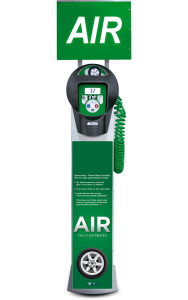Reduce greenhouse gas emissions within the transportation sector, reduce commuter fuel consumption, and raise environmental awareness to the public on emissions released by gasoline vehicles.
Burning a gallon of gasoline produces roughly 19 pounds of carbon dioxide (CO2). Furthermore, under-inflated tires drag on the surface of the road causing engines to work harder and emit an additional amount unnecessary gas.
Build a network of user-friendly digital air machines to provide free air for commuters, and reduce annual reported transportation emissions.


For every gallon of fuel burned by an average vehicle, approximately 19.6 lbs of CO2 (or 2.4 kg per liter) is displaced into the atmosphere.
Under-inflated tires cause vehicles to burn an additional ~1.2 billion gallons of fuel each year, which release an additional ~10.6 megatonnes of CO2 into the atmosphere.
Approximately 33% of vehicles on the road have at least one tire under-inflated by more than 10%.
Maintaining inflated tires improves fuel consumption (up to 3%), and has a direct impact towards greenhouse gas emission reduction and commuter fuel costs.
Public Benefits
Direct commuter savings in fuel consumption, dollars, and tire durability.
Educate commuters on the benefits of keeping tires inflated (i.e improve gas mileage by 3%) & how that translates to C02 and Cost savings.
Create environmental awareness and promote green mindsets.
Corporate Benefits
Enhance sustainability program with new innovative green initiative.
Employee Appreciation.
Pilot Program with no long-term commitment.
Annual CO2 emission savings year-end report which help with Scope 3 emissions reported.


ENGAGE
Let’s chat on how we can help create a new green initiative program.
We are here to help.
MONITOR
Annually monitor each location to determine the number of tires inflated and correlate to CO2 savings.
EDUCATE
Directly educate commuters on the benefits of inflating tires and create environmental awareness.
REPORT
Provide an annual CO2 emission reduction report per location. Lets see how much CO2 we can save.
